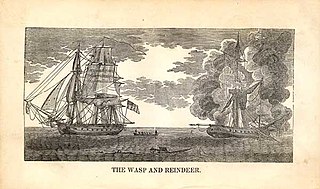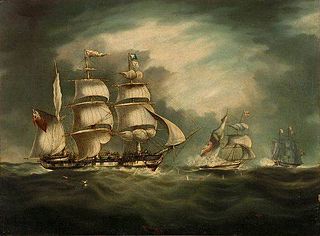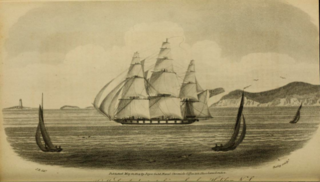
HMS Majestic was a 74-gun third-rate ship of the line launched on 11 December 1785 at Deptford.

HMS Saturn was a 74-gun third-rate ship of the line of the Royal Navy, launched on 22 November 1786 at Northam. The vessel served during the Napoleonic Wars with the Channel Fleet, taking part in the 1801 Battle of Copenhagen. With the beginning of the War of 1812, Saturn was modified to become a frigate designed to take on large American vessels of that type. Saturn was deployed as part of the blockading squadron of New York City from 1814 to 1815. From 1825, the vessel was in harbour service and was broken up in 1868.

HMS Bulwark was a 74-gun third-rate ship of the line of the Royal Navy, launched on 23 April 1807 at Portsmouth. She was designed by Sir William Rule as one of the large class 74s, and was the only ship built to her draught. She was built at Portsmouth Dockyard by Nicholas Diddams.
HMS Elizabeth was a 74-gun third-rate ship of the line of the Royal Navy, launched on 23 May 1807 at Blackwall.

HMS Cumberland was a 74-gun third rate ship of the line of the Royal Navy, launched on 19 August 1807 at Northfleet. During the Napoleonic wars she brought King William I of the Netherlands from London to The Netherlands.

HMS Venerable was a 74-gun third-rate ship of the line of the Royal Navy, launched on 12 April 1808 at Northfleet.
USS Gallatin was a post-Revolutionary War sailing vessel that the U.S. Department of the Treasury purchased at Norfolk, Virginia, for the United States Revenue-Marine in December 1807. An explosion on board destroyed her in 1813.

HMS Reindeer was a Royal Navy 18-gun Cruizer-class brig-sloop of the Royal Navy, built by Samuel & Daniel Brent at Rotherhithe and was launched in 1804. She was built of fir, which made for more rapid construction at the expense of durability. Reindeer fought in the Napoleonic Wars before succumbing in 1814 to the guns of USS Wasp during the War of 1812.

HMS Acasta was a 40-gun Royal Navy fifth-rate frigate. She saw service in the French Revolutionary and Napoleonic Wars, as well as the War of 1812. Although she never took part in any notable single-ship actions nor saw action in a major battle though she was at the Battle of San Domingo, she captured numerous prizes and rid the seas of many Spanish, French, and American privateers. She was finally broken up in 1821.

HMS Belle Poule was a Royal Navy fifth-rate frigate, formerly Belle Poule, a Virginie-class frigate of the French Navy that had been built by the Crucy family's shipyard at Basse-Indre to a design by Jacques-Noël Sané. She was launched on 17 April 1802, and saw active service in the East. In 1806 a British squadron under Sir John Borlase Warren captured her off La Palma in the Canary Islands. The Admiralty commissioned her into the Royal Navy as HMS Belle Poule. She was sold in 1816.
HMS Niemen was a Royal Navy 38-gun fifth-rate frigate. She began her career as the Niémen, a 44-gun French Navy Armide-class frigate, designed by Pierre Rolland. She was only in French service for a few months when in 1809 she encountered some British frigates. The British captured her and she continued in British service as Niemen. In British service she cruised in the Atlantic and North American waters, taking numerous small American prizes, some privateers but mostly merchantmen. She was broken up in 1815, at the end of the Napoleonic Wars and the War of 1812.
HMS Highflyer was originally an American privateer schooner built in 1811. As a privateer she took several British vessels as prizes. The Royal Navy captured her in 1813. She then participated in several raids on the Chesapeake and coastal Virginia before the Americans recaptured her later in 1813.
HMS Canso was the American letter of marque schooner Lottery, launched in 1811, that a British squadron captured in 1813. The Royal Navy took Lottery into service as HMS Canso and she served during the War of 1812 and briefly thereafter. The navy sold her in 1816.
HMS Hawk was an 18-gun sloop-of-war, previously the French privateer Atalante, that HMS Plantagenet captured in 1803. The Royal Navy took Atalante into service as HMS Hawk; she foundered in 1804.

HMS Atalante was an 18-cannon sloop-of-war launched in 1808, and ordered in 1806, from Bermuda. However, the ship was wrecked on 10 November 1813, caused by fog off Halifax, Nova Scotia.
Tartar was an unsuccessful American privateer schooner during the War of 1812. She was launched in 1813 and was driven ashore and destroyed on her maiden voyage at the end of the year, not having captured anything.

HMS Narcissus was the lead ship of the Royal Navy Narcissus-class 32-gun fifth-rate frigates, launched in 1801. She participated in the War of 1812.
Sarah Ann was a United States privateer commissioned at Baltimore in 1812. She captured a British merchantman in a single-ship action before HMS Rhodian captured Sarah Ann on 16 September 1812.
HMS Barbadoes was a 16-gun vessel, the American Herald, captured in 1813. The Royal Navy took her into service as HMS Barbadoes She captured a number of merchantmen and privateers before she was paid-off in May 1816. In 1814–1815 she also captured three Spanish and French slave ships carrying over 1100 enslaved people. Barbadoes became a powder ship in Jamaica that was later wrecked with her remains being sold.
HMS Cockchafer was a United States schooner, formerly named Spencer, that the Royal Navy (RN) captured and employed as a ship's tender. She captured two American armed brigs, one in a single-ship action. The Navy sold her in 1815.












